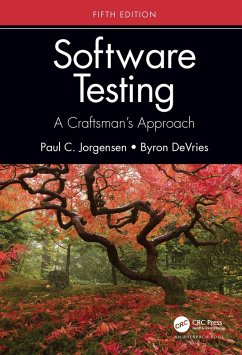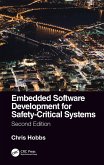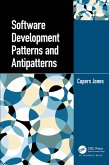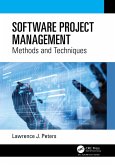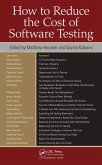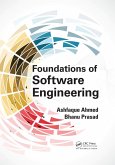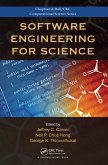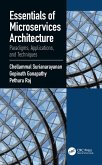43,95 €
43,95 €
inkl. MwSt.
Sofort per Download lieferbar

22 °P sammeln
43,95 €
Als Download kaufen

43,95 €
inkl. MwSt.
Sofort per Download lieferbar

22 °P sammeln
Jetzt verschenken
Alle Infos zum eBook verschenken
43,95 €
inkl. MwSt.
Sofort per Download lieferbar
Alle Infos zum eBook verschenken

22 °P sammeln
- Format: PDF
- Merkliste
- Auf die Merkliste
- Bewerten Bewerten
- Teilen
- Produkt teilen
- Produkterinnerung
- Produkterinnerung

Bitte loggen Sie sich zunächst in Ihr Kundenkonto ein oder registrieren Sie sich bei
bücher.de, um das eBook-Abo tolino select nutzen zu können.
Hier können Sie sich einloggen
Hier können Sie sich einloggen
Sie sind bereits eingeloggt. Klicken Sie auf 2. tolino select Abo, um fortzufahren.

Bitte loggen Sie sich zunächst in Ihr Kundenkonto ein oder registrieren Sie sich bei bücher.de, um das eBook-Abo tolino select nutzen zu können.
The 5th Edition of Software Testing: A Craftsman's Approach is a major update that adds new sections on model-based testing and the feature interaction testing. A major change is the shift to Java code for both the procedural and object-oriented examples.
- Geräte: PC
- mit Kopierschutz
- eBook Hilfe
Andere Kunden interessierten sich auch für
![Embedded Software Development for Safety-Critical Systems, Second Edition (eBook, PDF) Embedded Software Development for Safety-Critical Systems, Second Edition (eBook, PDF)]() Chris HobbsEmbedded Software Development for Safety-Critical Systems, Second Edition (eBook, PDF)70,95 €
Chris HobbsEmbedded Software Development for Safety-Critical Systems, Second Edition (eBook, PDF)70,95 €![Software Development Patterns and Antipatterns (eBook, PDF) Software Development Patterns and Antipatterns (eBook, PDF)]() Capers JonesSoftware Development Patterns and Antipatterns (eBook, PDF)51,95 €
Capers JonesSoftware Development Patterns and Antipatterns (eBook, PDF)51,95 €![Software Project Management (eBook, PDF) Software Project Management (eBook, PDF)]() Lawrence J. PetersSoftware Project Management (eBook, PDF)49,95 €
Lawrence J. PetersSoftware Project Management (eBook, PDF)49,95 €![How to Reduce the Cost of Software Testing (eBook, PDF) How to Reduce the Cost of Software Testing (eBook, PDF)]() How to Reduce the Cost of Software Testing (eBook, PDF)69,95 €
How to Reduce the Cost of Software Testing (eBook, PDF)69,95 €![Foundations of Software Engineering (eBook, PDF) Foundations of Software Engineering (eBook, PDF)]() Ashfaque AhmedFoundations of Software Engineering (eBook, PDF)82,95 €
Ashfaque AhmedFoundations of Software Engineering (eBook, PDF)82,95 €![Software Engineering for Science (eBook, PDF) Software Engineering for Science (eBook, PDF)]() Software Engineering for Science (eBook, PDF)46,95 €
Software Engineering for Science (eBook, PDF)46,95 €![Essentials of Microservices Architecture (eBook, PDF) Essentials of Microservices Architecture (eBook, PDF)]() Chellammal SurianarayananEssentials of Microservices Architecture (eBook, PDF)48,95 €
Chellammal SurianarayananEssentials of Microservices Architecture (eBook, PDF)48,95 €-
-
-
The 5th Edition of Software Testing: A Craftsman's Approach is a major update that adds new sections on model-based testing and the feature interaction testing. A major change is the shift to Java code for both the procedural and object-oriented examples.
Dieser Download kann aus rechtlichen Gründen nur mit Rechnungsadresse in A, B, BG, CY, CZ, D, DK, EW, E, FIN, F, GR, HR, H, IRL, I, LT, L, LR, M, NL, PL, P, R, S, SLO, SK ausgeliefert werden.
Produktdetails
- Produktdetails
- Verlag: Taylor & Francis eBooks
- Seitenzahl: 550
- Erscheinungstermin: 28. Juni 2021
- Englisch
- ISBN-13: 9781000391497
- Artikelnr.: 61970184
- Verlag: Taylor & Francis eBooks
- Seitenzahl: 550
- Erscheinungstermin: 28. Juni 2021
- Englisch
- ISBN-13: 9781000391497
- Artikelnr.: 61970184
- Herstellerkennzeichnung Die Herstellerinformationen sind derzeit nicht verfügbar.
Paul C. Jorgensen, Ph.D., spent 20 years of his first career developing, supporting, and testing telephone switching systems. Since 1986, he has been teaching graduate courses in software engineering, first at Arizona State University, and then at Grand Valley State University. As of August 2017, he became a Professor Emeritus of Computer Science at Grand Valley State University. He claims he is not retired, he just has a 7-day weekend, every week. Paul is a co-author of two McGraw-Hill books (1970 and 1992). In addition to his software testing book, he is the author of two other CRC Press books: Modeling Software Behavior-A Craftsman's Approach and The Craft of Model-Based Testing. He has reactivated his consulting practice, Software Paradigms, working with companies in Europe and North America.
Byron DeVries, Ph.D., currently teaches graduate and undergraduate courses in software engineering at Grand Valley State University. Previously, he directed the testing of flight-worthy avionics software during his 12-year career in the aviation systems industry. His research interests are the in the modeling and verification of high-assurance adaptive cyber-physical systems.
Byron DeVries, Ph.D., currently teaches graduate and undergraduate courses in software engineering at Grand Valley State University. Previously, he directed the testing of flight-worthy avionics software during his 12-year career in the aviation systems industry. His research interests are the in the modeling and verification of high-assurance adaptive cyber-physical systems.
Part I. A Mathematical Context. Chapter 1. A Perspective on Testing. Chapter 2. Examples. Chapter 3. Discrete Math for Testers. Chapter 4. Graph Theory for Testers. Part II. Unit Testing. Chapter 5. Boundary Value Testing. Chapter 6. Equivalence Class Testing. Chapter 7. Decision Table-Based Testing. Chapter 8. Code-Based Testing. Chapter 9 Testing Object-Oriented Software. Chapter 10. Retrospective on Unit Testing. Part III. Beyond Unit Testing. Chapter 11. Life Cycle-Based Testing. Chapter 12. Integration Testing. Chapter 13. System Testing. Chapter 14. Model-Based Testing. Chapter 15. Software Complexity. Chapter 16. Testing Systems of Systems. Chapter 17. Feature Interaction Testing. Chapter 18. Case Study: Testing Event-Driven Systems. Chapter 19. A Closer Look at All Pairs Testing. Chapter 20. Software Technical Reviews. Chapter 21. Epilogue: Software Testing Excellence.
Part I. A Mathematical Context. Chapter 1. A Perspective on Testing. Chapter 2. Examples. Chapter 3. Discrete Math for Testers. Chapter 4. Graph Theory for Testers. Part II. Unit Testing. Chapter 5. Boundary Value Testing. Chapter 6. Equivalence Class Testing. Chapter 7. Decision Table-Based Testing. Chapter 8. Code-Based Testing. Chapter 9 Testing Object-Oriented Software. Chapter 10. Retrospective on Unit Testing. Part III. Beyond Unit Testing. Chapter 11. Life Cycle-Based Testing. Chapter 12. Integration Testing. Chapter 13. System Testing. Chapter 14. Model-Based Testing. Chapter 15. Software Complexity. Chapter 16. Testing Systems of Systems. Chapter 17. Feature Interaction Testing. Chapter 18. Case Study: Testing Event-Driven Systems. Chapter 19. A Closer Look at All Pairs Testing. Chapter 20. Software Technical Reviews. Chapter 21. Epilogue: Software Testing Excellence.
